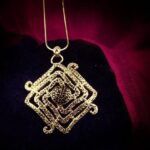The history of jewelry in spiritual practice dates back centuries to many different religions and cultures around the world. For many ancient societies, jewelry was an important part of religious and ceremonial customs, often signifying a person’s status within the community or serving as body ornamentation for shamanic rituals.
Jewelry is thought to contain spiritual power, with symbols and figures possessing various meanings or offering protection against supernatural forces. Furthermore, it could be used as a form of communication among the gods, such as in ancient Egyptian culture where necklaces were believed to bring good fortune – even royalty would wear special amulets that symbolized their divine right to rule.
In modern times, jewelry still has an integral role in spiritual practice and is often used as a form of expression. Jewelry can be worn or held during meditative practices as an aid in self-reflection or inner peace. It is also widely believed that wearing certain pieces can create energetic connections between the wearer and the surrounding environment.
For example, copper bracelets are believed to have healing properties for their actions on electromagnetic fields in the body. Similarly, gemstones are said to work with those same energies on a deeper level by aligning chakras, promoting emotional balance, and helping maintain physical health – there are even stones specifically chosen for particular purposes related to spirituality such as turquoise for divinatory meditation or amethyst for dreamwork and astral projection.
Additionally, some people choose jewelry featuring spiritual symbols such as crosses, pentagrams, floral designs (flower of life), mandalas (Om), etc., depending on their faith or purpose of use.
Overall, jewelry has been present since primitive civilizations began but it is especially significant today – it allows people an individualistic approach to religious practice and offers them the opportunity to express themselves through adornment while exploring spiritual depths through symbolism.
Whether they are looking for protection from evil forces or something more personal like inner harmony, each piece contains its own unique energy that resonates with its wearer’s intentions thus allowing them further access into their individual worlds and selves.
Ancient Origins of Jewelry and Its Spiritual Role in Religion
Jewelry has been a part of religious practice for thousands of years and across all cultures. Modifications and adornments of an individual’s body has served as a way to express faith, spiritual beliefs and cultural identity. Archaeological evidence suggests that the ancient Egyptians first began creating personal ornaments such as rings, necklaces, armlets, anklets and headdresses more than 5500 years ago.
These pieces were carved from precious stones or metals like silver, gold, lapis lazuli and turquoise to represent the Egyptian gods and goddesses. This symbolic jewelry was often given as gifts during sacred ceremonies and was even believed to hold a person’s soul after their death.
In Hinduism, jewelry is used as offerings to deities during prayer rituals along with flowers and fragrant incense. Hindu priests wear elaborate crowns made from precious jewels set in gold for important religious ceremonies. These jewels are thought to symbolize certain divine qualities such as courage or connection with the divine power.
The use of spiritual jewelry in this context was so significant that some believed if worn regularly it could bring good fortune into one’s life. Similarly, some Buddhism traditions also incorporate jewelry-making practices wherein mandalas are etched onto metal objects such as rings made from copper alloyed with zinc which are then adorned with detailed engravings of shapes representing cosmic balance along with protective symbols such as the lotus flower or Buddha eyes motif.
In Judaism, men typically wear a kabbalah bracelet that consists of red string said to be blessed by holy people at gravesites near Jerusalem in order to protect them against harm or lack prosperity in their lives. Another significant cultural expression found throughout many religions is the wearing of amulets known for its special properties designed to ward away bad luck or invoke positive energies from the gods or heavens above.
It is these seemingly small tokens made from popular materials such as jadeite, amber, jasper garnet ironwood ice among many others that give us insight into our shared beliefs across different cultures while offering practical tools for adapting our lives in today’s world around it.
Symbolism of Gemstones, Metals and Their Spiritual Uses
Since ancient times, jewelry has been used in spiritual practice. From the Sumerians of Mesopotamia to the Indus Valley civilizations, wearing specific jewelry was a way to channel divine forces. Ancient Greeks and Romans believed that gems each contained spiritual and mystical powers and religions such as Christianity, Islam, Hinduism and Buddhism also adopted these beliefs. For example, Buddhists place great importance on amulets or “talismans” – small pieces of jewelry worn for protection or for spiritual power.
Today there is still much interest in using jewelry for its religious symbolism and spiritual power. Jewelry has come to represent different aspects of faith, such as faith in one’s own path or the wish to honor a particular deity or tradition. Many pieces use gemstone beads with their well-known properties-hematite for grounding; rose quartz to bring love; tiger’s eye for courage-or precious metal charms like pendant crosses as symbols of faith.
In some forms of spiritual practice, gold is said to have divine energies that bring healing and guidance while silver is believed to attract psychic energies into rituals and magical practices. Rings made from these metals are often used in ceremonies such as weddings or engagements because they represent eternal commitment between two people which is reminiscent of divinely unioned souls joined together under the will of God.
Of course not all religious symbols are centered around precious silver and gold materials; symbols like the yin/yang can be found on various pieces ranging from wood necklaces to t-shirts – it’s all about what feels right for you personally.
Protection and Divine Access Through Jewelry
Jewelry has long been used in spiritual practice dating back to ancient cultures. Ancient Egyptians believed that adorning themselves with precious stones could help bring protection and access to the divine.
These unique precious objects were symbols of their connection to the gods, helping them protect and meditate on their spiritual beliefs. While royal jewelry such as a bejeweled mask or religious figures were used in ceremonies, everyday jewelry was also utilized to maintain a connection with the gods day to day.
The use of jewelry expanded beyond physical adornment and religion during this time as well; it was also used in holistic practices aimed at healing body, mind, and soul. Various gemstones would be crafted into bracelets and necklaces meant to soothe ailments both physically and emotionally.
Spiritual healers were known to wear amulets made from certain materials sought after for their magical properties. These weren’t just worn for aesthetic purposes, but rather part of a comprehensive self-care practice for those seeking guidance spiritually.
Although ancient spiritual practices are still being utilized today, much has changed over time. Different cultures carry different traditions when it comes to jewelry for spirituality-think Mala beads for Hindus or a Star of David pendant for Jews – symbolic objects adapted over time to fit within new contexts geographically or culturally speaking.
Yet each token is still special its own way close to that individual’s own understanding of its purpose – whether through visualization exercises while focusing on intention setting or simply feeling connected through the physical symbolism wearing the piece provides them in daily life. As they say, “beauty is more than skin deep” – it can take us straight into our core belief systems when we use it right.
Varied Usages of Jewelry in Various Religious Traditions
Jewelry has long been used in religious traditions around the world. It is often used as a way to connect with certain deities, protect against negative energy and acts as an offering or sacrifice to God or gods. Jewelry has also served various other purposeful or symbolic roles while being intertwined in spiritual practice. In monotheistic faiths such as Christianity, Judaism and Islam, jewelry is worn as an outward sign of faith.
In Hinduism, jewelry plays a heavy role in many rituals and ceremonies. Hindus use necklaces made out of specific gemstones and coins with images of various gods printed on them.
These necklaces may be blessed by priests beforehand or presented by family to initiate children into traditional customs such as marriage. Necklaces are also used for the worshipping of small household gods called pujas, which are usually kept at home among pictures of one’s ancestors and family members who have passed away.
Buddhists also impose spiritual significance upon jewelry items albeit often for ascetic purposes. Buddhist malas contain 108 beads plus one guru bead; each bead represents a prayer or a quality to cultivate within oneself.
Malas made from fragrant seeds are used in meditation ceremonies performed during puja (offering). Similarly Buddhist monks may wear prayer beads to keep track of their daily exercises: the cleansing of body and mind and clearing away one’s negative emotions such as anger, fear, pride etc.
Jewelry As a Sign of Wealth, Power, and Prestige
The relationship between jewelry and spiritual practice has a very rich and long history. Jewelry was a sign of wealth, power, and prestige in many ancient cultures. It denoted status, marked important life events, and sometimes even possessed magical powers.
In some societies, it was expected that a person would wear certain types of jewelry to signify their allegiance to a particular social group or religious community. In others, the materials used as well as the shapes and patterns in which the pieces were made held symbolic meanings that went beyond their physical properties.
Jewelry has been integral to spiritual practices both old and new. In some religions it is used to channel divine energy or spirits for the purpose of healing or protection.
Ancient Egyptians wore protective amulets made from lapis lazuli and turquoise that could be inscribed with magical spells or symbols believed to protect them from evil forces. Hinduism also has a deep association with jewelry; there are several sacred objects worn in accordance with belief such as vermilion forehead marks (symbolizing auspiciousness) necklaces adorned with sacred gemstones like rudraksha beads (associated with Lord Shiva) or Tulsi malas (used for chanting mantras).
In various indigenous cultures jewelry plays an important role in rituals such as ancestor worship ceremonies where pieces are regarded as intermediaries between worshippers and the spirit world. Perhaps one of the best examples can be found in the African Masai tribe where women wear beaded collars specifically designed for fertility rituals intended to bring positive influence into daily life activities such as marriage or childbirth.
This tradition dates back centuries and demonstrates how deeply embedded jewelry is in spiritual practice across many cultures around the world today.
How Jewellery Carries Spiritual Significance in Modern Times
The spiritual significance of jewellery can be traced back centuries among different cultures and religions, used as a form of decoration or an expression of religious belief. Ancient Egyptians believed that different pieces of jewellery not only had the power to represent gods, but also protect them in the afterlife.
It was widely believed by many cultures throughout history that certain gems and metals served as talismans against bad luck and spirits. This idea has been adopted by modern religion and has often become seen as a visual representation of faith, such as wearing crosses around their neck or pendants representing their god.
In many spiritual societies today, wearing items that carry special spiritual meanings have become popular ways to show connection to specific beliefs and gods. Some faiths traditionally use pieces such as rings, one example being the mezuzah necklace from the Jewish culture, which symbolizes God’s love for us on Earth.
Within Christian culture, special items such as crucifix necklaces or rosaries made from pearls can be used when praying in order to bring peace and serenity into our lives – these are worn both by adults and children alike.
New Age adherentsoften wear charms and precious stones such as amethyst crystal for healing purposes essential oilsused for mitigating stress or resolving issues with mental clarity. In addition to this, witches often wear amulets filled with runes, symbols or magickal transmutation rings designed to keep away negative energies – all working towards creating spiritual balance and focus within their practice while protecting them from any outside nastinesses.
Regardless what your faith tradition is – jewelry clearly has major importance in many religious practices across temple traditions-regardless time period old thread – today’s world too.
Furthermore there are many different forms of jewelry embraced based on any type of devotion-from necklaces with Egyptian hieroglyphics adorned with someone’s zodiac sign or even handmade creations created through manifestation magic . Ultimately-jewelry does connects us; beyond self to wider spirit loving community on multiple levels.
Conclusion
People around the world have been using jewelry for spiritual practice since ancient times. The use of jewelry in spiritual practice has evolved in different ways over time, from being seen as protective amulets used to ward off evil spirits, to being used as healing talismans or worn as religious symbols. Depending on the cultural context, different types of gems or metal were seen to possess certain powers or meanings that can bring enlightenment and well-being.
For example, in Ancient Egypt precious metals such as gold were associated with divinity and immortality while sacred stones like lapis lazuli were believed to provide insight and wisdom. Other materials such as copper and silver were also used for various purposes including healing and protection against spirits.
The role of jewelry in spiritual practice is still very apparent today. Many believe that wearing certain pieces can bring you good luck, health, success or whatever other qualities you might be seeking through your prayer or meditation practices. While some just wear jewelry for its aesthetic value, many use it as a tool for connecting spiritually with their higher power and finding inner peace.
Moreover, it cannot be denied that wearing certain pieces of jewelry has become a symbol of personal identity and social stature. From its early days jewelry was seen to be connected with status; nowadays many people associate wearing certain pieces with their personality or beliefs they want to show outwardly.
For example – many followers of Hinduism will wear a bindi (also known as a tilak) which is said to represent the mind’s eye that leads towards devotion and enlightenment – something which depending on its type will help the wearer feel more connected to their spiritual practice.
Overall Jewelry has had an undeniable impact when it comes to its role in spiritual practice over centuries around the world. It is no longer solely seen as protective amulets used to ward off evil entities but also a symbol of self-expression – allowing individuals to express what aspect(s) of their faith are important them personally without having to speak about it verbally.

Welcome to my jewelry blog! My name is Sarah and I am the owner of this blog.
I love making jewelry and sharing my creations with others.
So whether you’re someone who loves wearing jewelry yourself or simply enjoys learning about it, be sure to check out my blog for insightful posts on everything related to this exciting topic!





